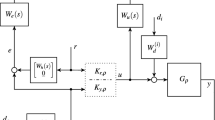Abstract
This paper presents a practical design of longitudinal stability and control augmentation system (SCAS) using a two degree of freedom (TDOF) controller. It is based on the linear quadratic regulator (LQR) technique in the frequency domain, via spectral factorization. The controller exhibits robustness to plant uncertainties, related with variation due to different operation conditions, and incorporates various aircraft handling qualities (HQ) requirements to comply with certification authority’s requests. The project results in an unique set of fixed gain TDOF controller for a plant dynamics which changes with a \(V_{\text {CAS}}\times x_{\text {cg}}\) envelope. The project is done aiming at the industrial implementation of TDOF controller in fly-by-wire aircrafts.

















Similar content being viewed by others
Notes
Selective Compliance Assembly Robot Arm.
Adapted from http://www.wpclipart.com/transportation/aircraft/jet
Abbreviations
- \(x_{cg}\) :
-
Center of gravity (%)
- \(\omega _{n}\) :
-
Natural frequency (rad/s)
- \(\phi\) :
-
Roll angle (rad)
- \(\theta\) :
-
Pitch angle (rad)
- \(\psi\) :
-
Yaw angle (rad)
- p :
-
Roll rate (rad/s)
- q :
-
Pitch rate (rad/s)
- r :
-
Yaw rate (rad/s)
- \(V_{\text {CAS}}\) :
-
Calibrated airspeed (knots)
- \(V_{\text {TAS}}\) :
-
True airspeed (m/s)
- \(\mathbf {V}\) :
-
Velocity vector (m/s)
- \(\alpha\) :
-
Attack angle (rad)
- \(\beta\) :
-
Sideslip angle (rad)
- \(\gamma\) :
-
Flight path angle (rad)
- \(\delta _{e}\) :
-
Elevator angle (rad)
- \(\tau\) :
-
Delay of sensor (ms)
- \(\tau _{p}\) :
-
Phase delay criteria (s)
- \(\zeta\) :
-
Damping factor (dimensionless)
- j :
-
Imaginary number (dimensionless)
- \(\rho\), \(\sigma\) :
-
Weighting factors (dimensionless)
- \(\kappa\) :
-
Steady state gain (dimensionless)
- \(\hat{q}(s)\), h(s), k(s):
-
Controller gains (dimensionless)
- \(x_{s}\) :
-
x axis stability coordinate system (dimensionless)
- \(x_{\omega }\) :
-
x axis wind coordinate system (dimensionless)
- \(x_{b}\) :
-
x axis body coordinate system (dimensionless)
References
Holzapfel F, Heller M, Weingartner M, Sachs G, da Costa O (2006) Development of control laws for the simulation of a new transport aircraft. In: 25th International Congress of the Aeronautical Sciences
Stevens BL, Lewis FL (2003) Aircraft control and simulation, 2nd Edn. Wiley, New York, USA
Leithead W (1999) Survey of gain scheduling: analysis and design. Int J Control 73:1001–1025
Nair VG, Dileep MV, George VI (2012) Aircraft yaw control system using lqr and fuzzy logic controller. Int J Comput Appl 9(45):25–30
Akyazi O, Usta MA, Akpinar AS (2012) A self-tuning fuzzy logic controller for aircraft roll control system. Int J Control Sci Eng 6(2):181–188 doi: 10.5923/j.control.20120206.06
Saussié D, Akhrif O, Saydy L (2005) Longitudinal flight control design with handling quality requirements. Département de génie électrique École Polytenchique de Montréal et École de Technologie Superieure, Janvier
Townsend BK (1986) The application of quadratic optimal cooperative control synthesis to a CH-47 Helicopter, 1st edn. NASA Technical Memorandum 88353
Gangsaas D, Bruce K R, Blight JD, Ly UL (1986) Application of modern synthesis to aircraft control: three casestudies. IEEE Trans Autom Control:995–1014
Aouf N, Boulet B, Botez R (2002) A gain scheduling approach for a flexible aircraft. Proceeding of the American Control Conference, pp 4439–4442
Gangsaas D, Hodgkinson J, Harden C (2008) Multidisciplinary control law design and flight test demonstration on a business jet. AIAA Guidance, Navigation and Control Conference and Exhibit, pp 1–25
da Silva ASF, Paiva HM, Kienitz KH (2011) A methodology to assess robust stability and robust performance of automatic flight control systems. Rev Bras Controle Autom 22(5):429–440
Hassani K, Lee WS (2014) Optimal tunning of linear quadratic regulators using quantum particle swarm optimization. Procedings of the International Conference of Control, Dynamics and Robotics, pp 1–8
Siqueira D, Moreira FJO, PaglioneP (2007) Robust flight control design supported by flying qualities analysis. AIAA Guidance, Navigation and Control Conference, South Carolina, pp 1–8
Wolovich WA (1994) Automatic control systems: basic analysis and design, 2nd edn. The oxford Series in Electrical and Computer Engineering Series. Saunders College Pub, New York
Zhou K, Doyle JC (1997) Essentials of robust control, 1st edn. Prentice Hall, New Jersey
Vargas FJT ,de Pieri ER, Castelan EB (2004) Identification and friction compensation for an industrial robot using two degrees of freedom controllers. In: ICARCV, IEEE, pp 1146–1151
Vargas FJT (2004) Experimental implementation of robust and intelligent controllers in trajectory control of industrial scara robot. In: KaGnicheM (ed) Student Forum, IFIP 18 th World Computer Congress-Student Forum, 22–27 August 2004, Toulouse, France, Kluwer, pp 415–428
Duke EL, Antoniewicz RF, Krambeer KD (1988) Derivation and definition of a linear aircraft model, 1st edn. NASA Reference Publication 1207, USA
Stengel RF (2004) Flight dynamics, 1st edn. Princeton University Press, Princeton, NJ
MIL-F-8785C (1980) Flying qualities of piloted airplanes, Military Norm
Tischler MB (1996) Advancesin aircraft flight control, 1st edn. Taylorand Francis Publishers, London
AGARD/NATO (1991) Handling qualities of unstable highly augmentated aircraft. Advisory report, Research and Technology, North Atlantic Treaty Organization
David KA (1996) Comparison of the control anticipation parameter and the bandwidth criterion during the landing task. In: Master degree Thesis, Air Force Institute of Technology
Acknowledgments
The authors would like to thank to Daniel Siqueira for HQ’s templates, to seniors engineers Paulo Donato and Michel McSharry for the text reviews and finally to EMBRAER and ITA for financial support.
Author information
Authors and Affiliations
Corresponding author
Additional information
Technical Editor: Glauco A. de P. Caurin.
Rights and permissions
About this article
Cite this article
Vargas, F.J.T., de Oliveira Moreira, F.J. & Paglione, P. Longitudinal stability and control augmentation with robustness and handling qualities requirements using the two degree of freedom controller. J Braz. Soc. Mech. Sci. Eng. 38, 1843–1853 (2016). https://doi.org/10.1007/s40430-015-0444-z
Received:
Accepted:
Published:
Issue Date:
DOI: https://doi.org/10.1007/s40430-015-0444-z




